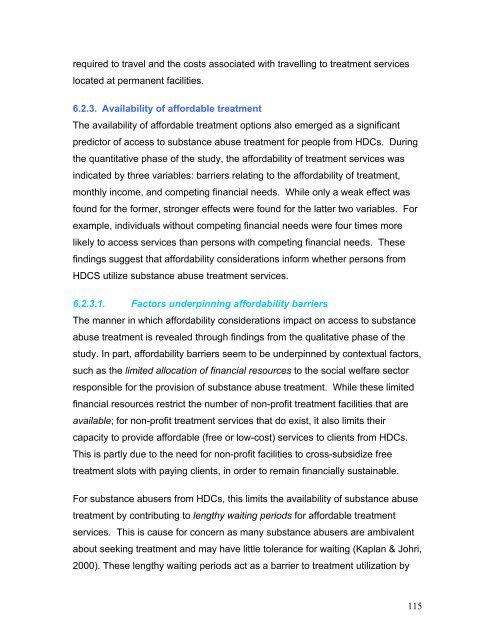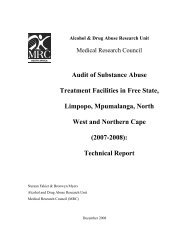Access to substance abuse treatment in the Cape Town metropole ...
Access to substance abuse treatment in the Cape Town metropole ...
Access to substance abuse treatment in the Cape Town metropole ...
Create successful ePaper yourself
Turn your PDF publications into a flip-book with our unique Google optimized e-Paper software.
equired <strong>to</strong> travel and <strong>the</strong> costs associated with travell<strong>in</strong>g <strong>to</strong> <strong>treatment</strong> serviceslocated at permanent facilities.6.2.3. Availability of affordable <strong>treatment</strong>The availability of affordable <strong>treatment</strong> options also emerged as a significantpredic<strong>to</strong>r of access <strong>to</strong> <strong>substance</strong> <strong>abuse</strong> <strong>treatment</strong> for people from HDCs. Dur<strong>in</strong>g<strong>the</strong> quantitative phase of <strong>the</strong> study, <strong>the</strong> affordability of <strong>treatment</strong> services was<strong>in</strong>dicated by three variables: barriers relat<strong>in</strong>g <strong>to</strong> <strong>the</strong> affordability of <strong>treatment</strong>,monthly <strong>in</strong>come, and compet<strong>in</strong>g f<strong>in</strong>ancial needs. While only a weak effect wasfound for <strong>the</strong> former, stronger effects were found for <strong>the</strong> latter two variables. Forexample, <strong>in</strong>dividuals without compet<strong>in</strong>g f<strong>in</strong>ancial needs were four times morelikely <strong>to</strong> access services than persons with compet<strong>in</strong>g f<strong>in</strong>ancial needs. Thesef<strong>in</strong>d<strong>in</strong>gs suggest that affordability considerations <strong>in</strong>form whe<strong>the</strong>r persons fromHDCS utilize <strong>substance</strong> <strong>abuse</strong> <strong>treatment</strong> services.6.2.3.1. Fac<strong>to</strong>rs underp<strong>in</strong>n<strong>in</strong>g affordability barriersThe manner <strong>in</strong> which affordability considerations impact on access <strong>to</strong> <strong>substance</strong><strong>abuse</strong> <strong>treatment</strong> is revealed through f<strong>in</strong>d<strong>in</strong>gs from <strong>the</strong> qualitative phase of <strong>the</strong>study. In part, affordability barriers seem <strong>to</strong> be underp<strong>in</strong>ned by contextual fac<strong>to</strong>rs,such as <strong>the</strong> limited allocation of f<strong>in</strong>ancial resources <strong>to</strong> <strong>the</strong> social welfare sec<strong>to</strong>rresponsible for <strong>the</strong> provision of <strong>substance</strong> <strong>abuse</strong> <strong>treatment</strong>. While <strong>the</strong>se limitedf<strong>in</strong>ancial resources restrict <strong>the</strong> number of non-profit <strong>treatment</strong> facilities that areavailable; for non-profit <strong>treatment</strong> services that do exist, it also limits <strong>the</strong>ircapacity <strong>to</strong> provide affordable (free or low-cost) services <strong>to</strong> clients from HDCs.This is partly due <strong>to</strong> <strong>the</strong> need for non-profit facilities <strong>to</strong> cross-subsidize free<strong>treatment</strong> slots with pay<strong>in</strong>g clients, <strong>in</strong> order <strong>to</strong> rema<strong>in</strong> f<strong>in</strong>ancially susta<strong>in</strong>able.For <strong>substance</strong> <strong>abuse</strong>rs from HDCs, this limits <strong>the</strong> availability of <strong>substance</strong> <strong>abuse</strong><strong>treatment</strong> by contribut<strong>in</strong>g <strong>to</strong> lengthy wait<strong>in</strong>g periods for affordable <strong>treatment</strong>services. This is cause for concern as many <strong>substance</strong> <strong>abuse</strong>rs are ambivalentabout seek<strong>in</strong>g <strong>treatment</strong> and may have little <strong>to</strong>lerance for wait<strong>in</strong>g (Kaplan & Johri,2000). These lengthy wait<strong>in</strong>g periods act as a barrier <strong>to</strong> <strong>treatment</strong> utilization by115
















